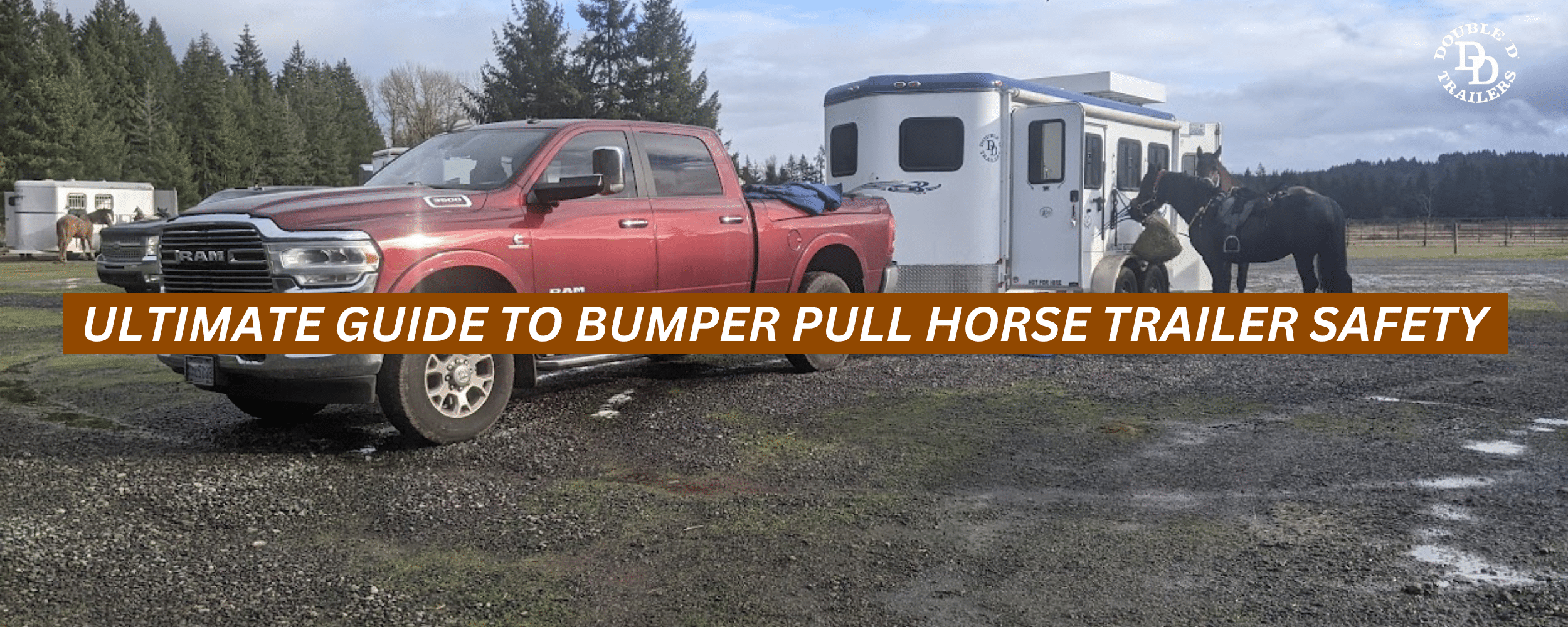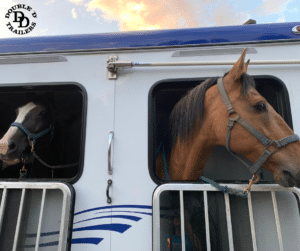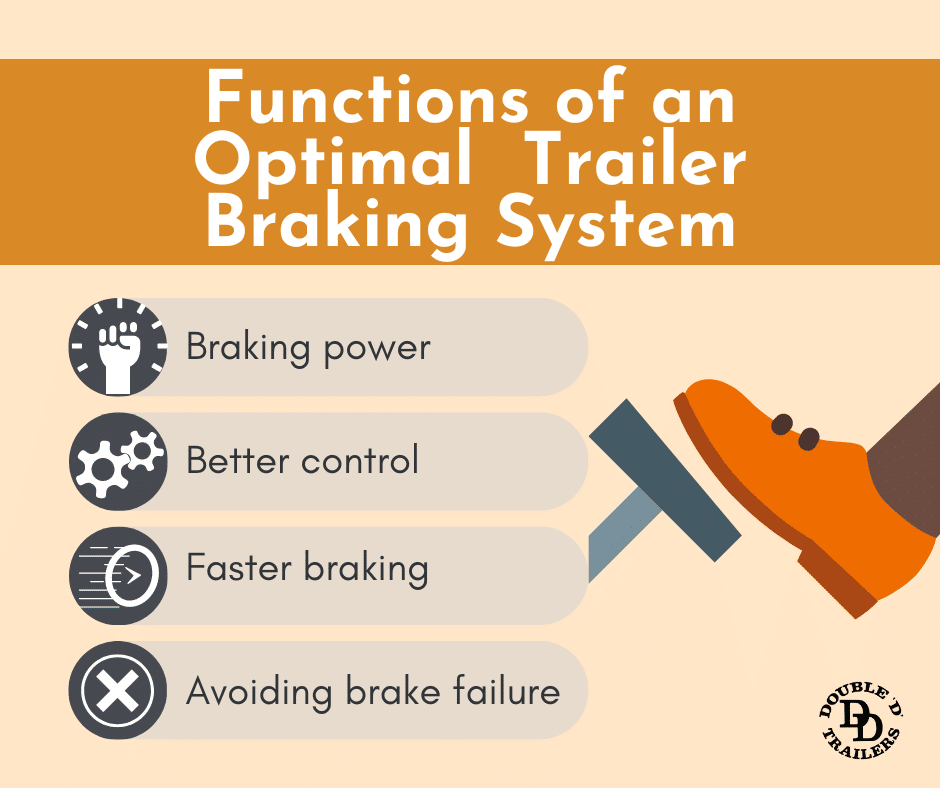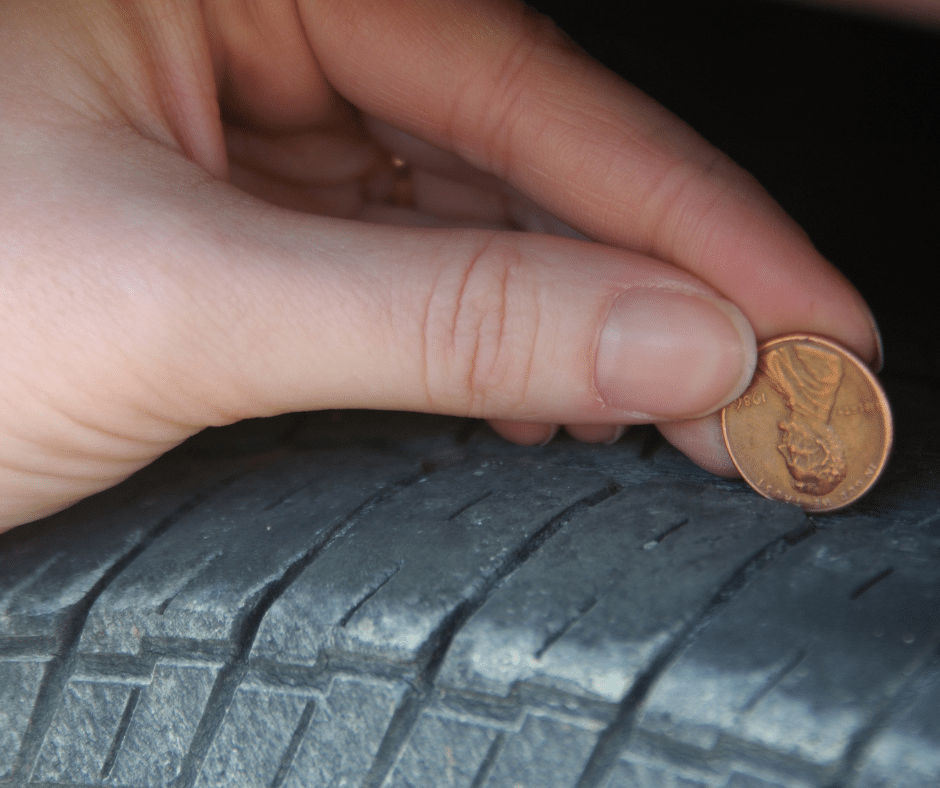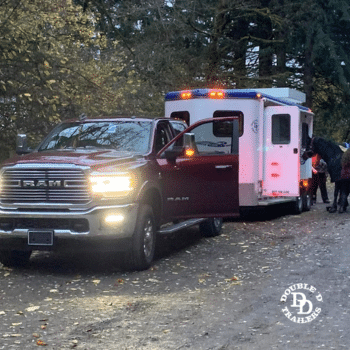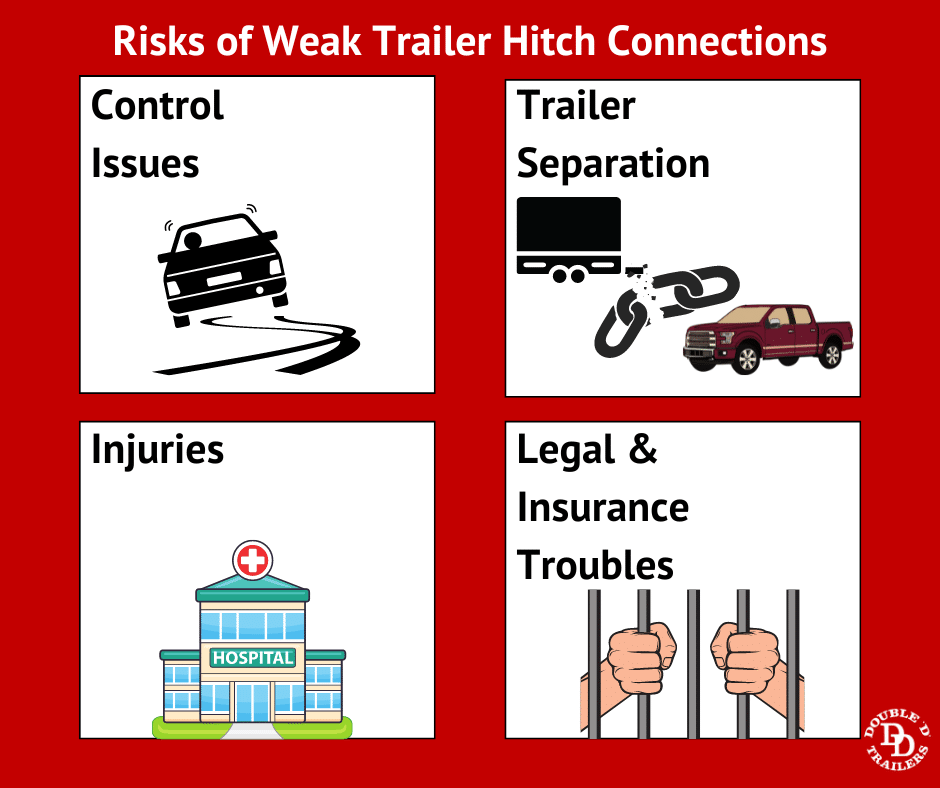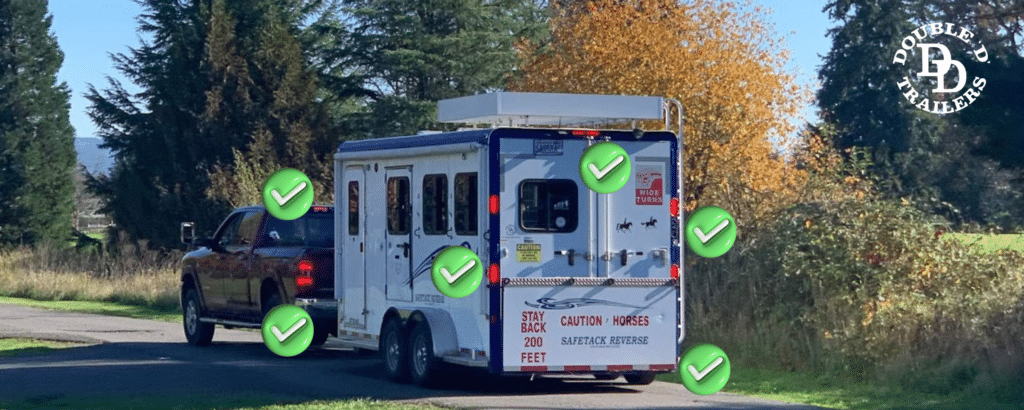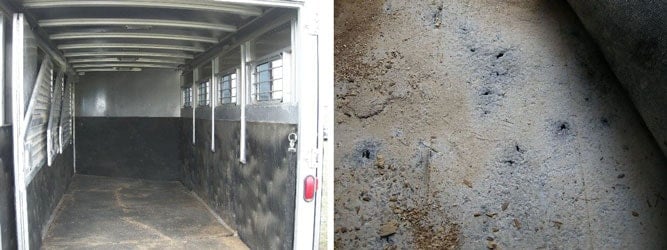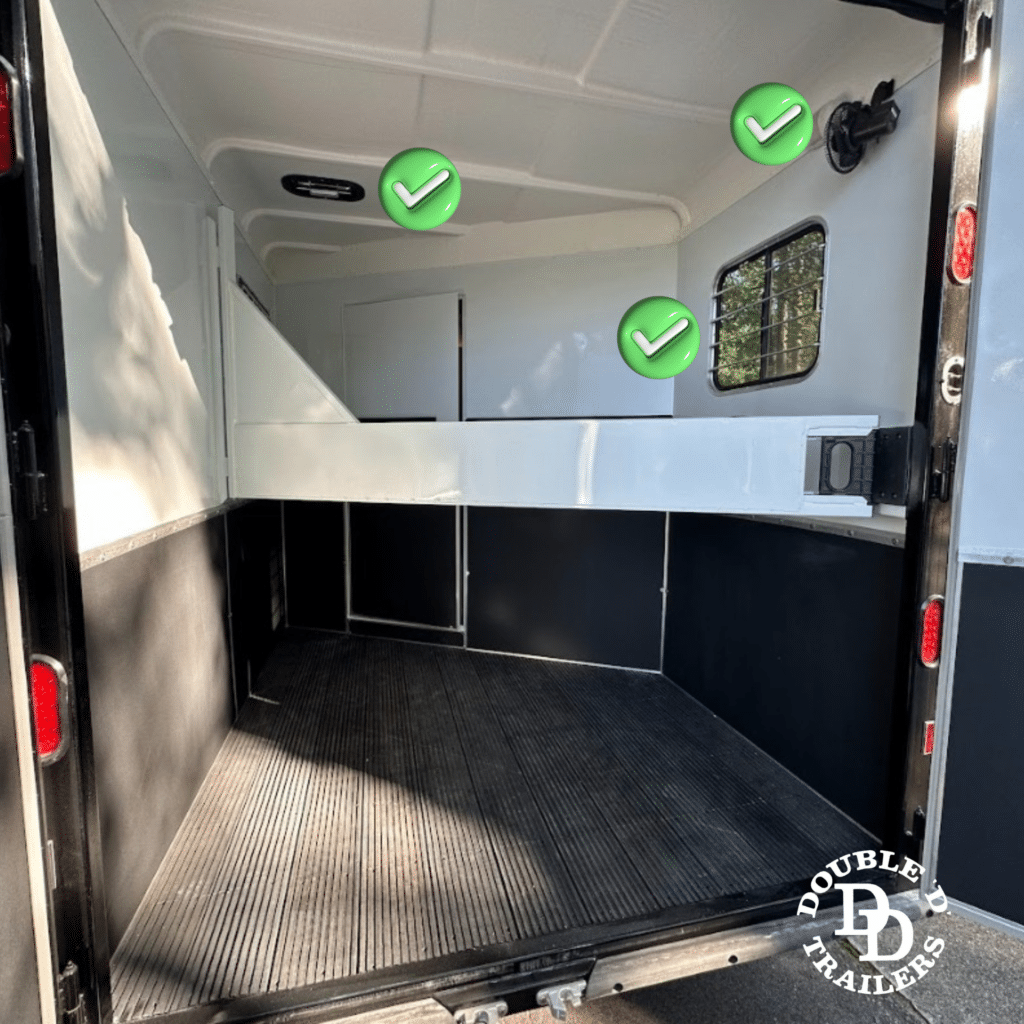The Ultimate Guide to Bumper Pull Horse Trailer Safety: Key Tips & Expert Insights
An old proverb states that a little stone may upset a large cart. Therefore, neglecting a single safety aspect of a bumper pull horse trailer is unacceptable. When safety is compromised, accidents are just waiting to happen. Seemingly insignificant factors such as incorrect tire pressure can result in injuries, liabilities, or repair bills.
Did you know that your tow vehicle’s specs matter just as much as the build quality and equipment of your bumper pull horse trailer, safety-wise? Or that small and affordable improvements can dramatically improve the well-being of your horses? In today’s guide, we’ll share key tips and expert insights on impeccable bumper pull horse trailer safety.
Key Considerations for Bumper Pull Horse Trailer Safety
Achieving ultimate bumper pull horse trailer safety compares to solving a complex equation comprising several factors: size and weight, horse health and behavior during transportation, braking system and tires, hitch connection, floor integrity, and more. In this section, we’ll focus on all these key horse trailer safety areas, starting with adequate BP horse trailer size and weight.
• Trailer Size and Weight
Considering the trailer size and weight of your new bumper pull horse trailer should be based on a few key factors: the number, breed, and size of your horses, as well as the capabilities of your tow vehicle. If you happen to need a larger trailer, you may also be forced to replace your current SUV with a larger pickup truck, for instance.
But it all starts with the number of horses you own. They should load/unload safely and enjoy enough stall space and headroom, which will determine the size, loading pattern, and carrying capacity of the bumper pull horse trailer you should acquire.
Why is the Right Trailer Size and Weight Crucial for Safety?
An article posted on the Equesure UK website states that overloaded trailers are one of the primary reasons for such events. Therefore, the trailer you choose should be capable of handling the weight of your horses and all supporting tack and gear. GVM (Gross Vehicle Mass) is the indicator to consider here: it describes the weight of the trailer itself and the additional weight it can carry, including payload and equipment.
How Does Vehicle Towing Capacity Impact Safety?
Your tow vehicle should be capable of pulling and handling the weight of your bumper pull horse trailer in terms of pulling power, braking, and cornering. Common towing risks that directly affect safety include underrated towing capability, excessive vertical tongue weight, imbalanced load, and mechanical stress on key components such as axles, tow bars, frames, and so forth. Confirming the tow vehicle’s factory specs make it a suitable choice and adding an adequate tow hitch are key factors of safe bumper pull horse trailer towing.
Understanding Hitch Types and Their Proper Installation
When it comes to bumper pull horse trailers, there are two types of hitch configurations: weight-carrying and weight-distributing. The former is the most popular type by far, and it’s always designed to carry the vertical load/tongue weight of the trailer. It comes in two designs: a receiver hitch and a step bumper hitch.
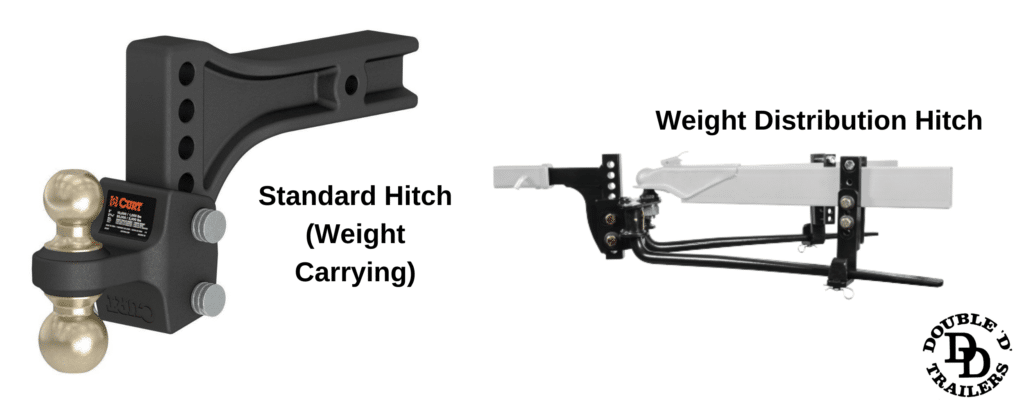
The weight-distributing type takes the weight-carrying design further and uses a load leveling system that distributes the tongue weight evenly instead of concentrating it on the rear end of the tow vehicle.
Proper installation of either type is just as important as choosing the right model, based on your needs. Opting for the correct ball size and adding safety chains are part of several important steps toward successful hitch system operation.
• Horse Health and Safety During Travel
A publication on TheHorse.com that shares insights by Dr. Barbara Padalino, Ph.D., who has studied equine transport effects on horses’ well-being, reveals several important factors to consider: injuries and health issues may occur during hauling if the horse trailer is not suitable for the horses’ size, behavior, and condition.
What are the Signs of Horse Stress During Travel?
Horses may experience fatigue and stress during transportation, and the common symptoms include reduced appetite, loss of balance, increased heart rate, erratic behavior, restlessness, sweating, or refusal to enter or exit the trailer. To avoid this, you should ensure enough headroom and space for movement and plenty of light. Horses despise confined spaces, and being in one for too long may trigger some of the abovementioned symptoms. Proper ventilation is also key for avoiding horse health issues during transportation by eliminating excessive heat and providing fresh air.
First Aid Essentials for Traveling with Horses
While on the road with your beloved horses, you should take no chances and carry all first aid supplies you might need in case of an injury or a health issue. Except for your vet’s contacts and a copy of the horses’ medical records (for a consultation if needed), you should carry several items on board your bumper pull horse trailer:
- Thermometer
- Bandages and wraps
- Cotton pads and rolls
- Saline and antiseptic solutions
- Syringes and needles
- Tourniquets
- Hoof pick and boot
- Painkillers
- Scissors
- Tweezers
- Antibacterial solution
- Flashlight
- Pocket knife
• Braking System
Current law in more than half of the U.S. requires trailers with a GVWR (Gross Vehicle Weight Rating) of above 3,000 pounds to be equipped with a braking system. An article by Kevan Garecki on Horse Journals confirms that inoperable brakes are a leading cause of horse trailer accidents on the road. Similar results were shared in the article Equine Transport-Related Problem Behaviors and Injuries: A Survey of Italian Horse Industry Members by Francesca Dai, Martina Zappaterra, et al.: some of the Italian equestrian respondents reported horse injuries as a result of accidents prior to which they didn’t check the brakes of their trailers. Therefore, regular maintenance and frequent safety checks are essential for guaranteeing horse trailer safety.
What Functions Should an Optimal Braking System Perform?
Except for legal compliance, horse trailer brakes greatly improve towing safety by serving several primary functions:
- Braking power: The main function of a bumper pull horse trailer’s braking system is obvious: to provide additional braking power instead of relying on the brakes of the tow vehicle.
- Better control: The braking system of a bumper pull horse trailer helps the driver control the trailer better by reducing the chance of violent swaying, especially when emergency braking is the only option or when going down a steep hill, for instance.
- Faster braking: Horse trailer brakes allow for shorter stopping distances, which could be the difference between safely coming to a stop or being involved in an accident.
- Avoiding brake failure: By taking the load off the tow vehicle’s braking system, having properly functioning bumper pull horse trailer brakes prolongs the life of your SUV or pickup’s brake discs and pads.
How Does Regular Maintenance Prevent Braking Failures?
A survey report on Horse Injury During Non-Commercial Transport by CB Riley et al., which is based on a wide-scope research, states that part of the users who reported not frequently changing the braking fluid of the hydraulic braking system of their trailers have reported accidents with their horse trailers. This shows that proper braking system maintenance is key for achieving the ultimate bumper pull horse trailer safety levels. Always follow the manufacturer's recommendations regarding servicing intervals, parts, and accessories.
Tire Condition
The four tires of your bumper pull horse trailer are the only parts it comprises that are in contact with the road surface, therefore, you should take good care of them and replace them when you should, depending on their age, the current season, possible load variations, the tread wear, and other factors.
What Indicators Suggest Your Tires Need Immediate Attention?
The indicators to look out for when inspecting your tires include but are not limited to the following list:
- You should check the depth of the tire tread and if it’s past the wear marker, you should replace all four tires at once. If you notice that one of the tires is worn more than the others, or that both tires on one side show uneven wear, this might indicate issues with the suspension geometry or the frame.
- Check for cracks: If you notice the rubber on the sidewall or tread has started to crack, this means that the tires have aged and need replacing.
- Always make sure to inflate all four tires properly: Tire pressure is a key component of caring for your horse trailer and enhancing its road safety. You should follow the recommended numbers in the user manual and adjust tire pressure depending on the current load of your trailer.
- Don’t experiment with tire size: There’s a reason for the recommended tire sizes by your manufacturer. Altering this may result in plenty of changes in the BP horse trailer’s performance related to braking, turning, comfort, and functionality.
- Rotate the tires as recommended: Most manufacturers recommend rotating the trailer’s tires every few thousand miles.
PRO TIP: Use the penny test! Simply place your penny upside down with the face towards you into a groove in your tire tread. Check to see if Lincoln's head is covered. If part of Lincoln's head is covered, your tires are good! If you can still see Lincoln's entire head, it's time to replace your tires.
How Often Should Tires Be Checked for Wear and Tear?
You should check your tires prior to every trip, but doing it occasionally if your trailer spends most of the time parked is a good idea. Tires can deform if the vehicle they’re mounted on is sitting for a long time. Here’s a checklist to use if you wonder how frequently you should check the tires of your bumper pull horse trailer:
- Once a month: When you perform a routine inspection of your trailer’s systems, don’t forget to check the tires for wear and sufficient pressure.
- Before you hit the road: Even if you checked the tires a week ago, do it one more time before you hook the trailer and set off.
- After a road emergency: If you were forced to slam on the brakes or go through a rough patch of road, you should pull over and inspect the tires of both your tow vehicle and horse trailer.
• Hitch Connection
The hitch connection between your tow vehicle and bumper pull horse trailer will always determine the performance of the rig and the towing experience of the driver. The quality of the hitch, its compatibility with the coupler, and all the additional accessories and safety features outline a successful and reliable hitch connection.
How to Securely Attach Your Trailer to the Towing Vehicle?
To properly hitch a trailer to your tow vehicle, you should follow these simple steps:
- Step 1: Inspect the hitch and check for missing bits, damage, excessive wear, cracks, compromised welds and joints, and other issues.
- Step 2: Confirm that the hitch ball and coupler are compatible and create a perfect connection.
- Step 3: Position your SUV or pickup truck: You need to align the tow vehicle with the trailer before attempting to connect them.
- Step 4: Lower the trailer coupler and lock it: With the latch mechanism in open position, the coupler should encase the ball snugly and you should be able to lock it into place using the lever. Place the safety pin into its correct position.
- Step 5: Hook up the safety chains by crossing them one over another following the common X pattern. The chains will hold the trailer’s front side up and keep it connected to the trailer if the hitch fails. Attach the electric breakaway system if available.
- Step 6: Perform a final check: Take your time and inspect everything: the electrical connections, the lights, and test the brakes before starting your journey.
What Risks Arise from a Weak Hitch Connection?
The article Runaway Trailer/Negligent Hitch Accidents posted on Miller and Zois's website, cites the National Highway Traffic Safety Administration (NHTSA), according to which approximately 50,000 hitch accidents happen every year, horse trailer hitches included. This whopping statistics goes to show how important proper hitch connections are. The risks related to hitching a horse trailer include:
- Control issues: Compromised hitch connections can lead to a complete loss of control over the trailer. This can lead to fishtailing or a rollover with disastrous results, with damage being the least that could happen.
- Trailer separation: The worst-case scenario is having the BP horse trailer completely separated from the tow vehicle. This could cause the trailer to collide with another vehicle or end up in a ditch, and the outcome of such accidents is always unpredictable.
- Injuries: The above scenarios could cause severe injuries to horses and humans, and, unfortunately, fatalities in some cases.
- Legal and insurance troubles: A failed hitch can lead to any of the issues above, but either of them would most certainly result in either legal or insurance trouble or both.
• Lighting & Signals
Proper lighting and signalization go a long way when it comes to bumper pull horse trailer safety. In this section, we’ll discuss how proper lighting can enhance safety and prevent accidents from happening.
How Do Proper Lighting Systems Enhance Visibility?
A bumper pull horse trailer’s interior and exterior can benefit from several lighting systems and solutions:
- The obligatory tail lights, brake lights, reverse lights, turn signals, license plate illumination, and other light fixtures required by law can be upgraded to modern LED units because of the lower power consumption and better visibility they offer, which enhances safety.
- Marker/clearance lights: Also referred to as running lights, this is a popular solution for outlining the trailer’s dimensions. These lights are usually found along the sides of a bumper pull horse trailer, as well as on all corners, top and bottom.
- Interior lights: Every corner of the horse area needs to be properly illuminated for the sake of horses’ comfort and for safety reasons.
- Loading/unloading lights: This is an invaluable solution that allows you to load or unload your horses safely when it’s dark outside and you can’t simply rely on a flashlight. In some cases, these lights can be controlled remotely through a wireless connection.
- Reflectors, reflective tape, and decals: Although not a means of illumination, such additions always enhance safety by providing the trailer with extra visibility, not to mention how much reflective tape and decals can add to the appeal of the horse trailer.
Why is it Essential to Regularly Check Signal Functionality?
It’s essential to regularly check all lights and electrical systems of your bumper pull horse trailer before you take it on the road because this could be the difference between a trouble-free trip and a disaster. Being fined for inoperative tail lights can be the least of your worries. If you experience complete rear light failure, someone could rear-end your trailer at night. In case of a rear-end collision, you could be the lead driver and still share the blame if your tail lights or hazard lights were not working prior to the accident. Therefore, performing a simple check before hitting the road is a must. Here’s how to do it:
- Check all electrical connections of your horse trailer.
- Start your tow vehicle and turn on all the lights to make sure there are no errors or faulty bulbs.
- Do a walk-around and inspect every lighting fixture for physical damage such as broken clips, cracks, or missing screws.
• Floor Integrity
The floor of your bumper pull horse trailer is an essential safety feature, or at least it needs to be considered as such. It’s part of the rig’s structural integrity and it’s also the one part that provides support for the horses inside, therefore, it should be robust, yet flexible, and covered with a non-slip surface material.
How to Inspect Your Trailer Floor for Potential Weak Spots?
You should expect the floor of your bumper pull horse trailer every time before you load your horses. Follow these simple steps to perform a thorough inspection:
- Step 1: Immobilize your trailer using wheel chocks – this is how you can be certain that the trailer will not move on its own while you’re inspecting it.
- Step 2: Make sure the floor and undercarriage are clean (removing dirt and debris from both is part of the essential maintenance of a BP horse trailer)
- Step 3: If there are floor mats or other materials covering the floor, remove them as well.
- Step 4: Check for compromised/ soft spots. Steel rusts and aluminum corrodes, which is why such issues may occur.
- Step 5: Use a hammer or a small pry bar to test areas that seem suspicious.
- Step 6: Inspect all joints and welds, as they are sometimes the weak spots that compromise the integrity of a horse trailer’s floor.
- Step 7: Check for gaps and leaks that might speed up rust and corrosion.
- Step 8: Assess the overall condition and address any issues that you found during the inspection.
What Materials Ensure a Strong and Durable Trailer Floor?
| Floor Type | Resistant to rust/corrosion | Provides a non-slip surface | Doesn't transfer heat | Reduces noise and vibration |
|---|---|---|---|---|
| Steel | No | No | No | No |
| Aluminum | No | No | No | No |
| Rumber | Yes | Yes | Yes | Yes |
| Wood | Yes | Yes | Yes | Yes |
How to Ensure Proper Ventilation for Horses’ Well-being in Bumper Pull Horse Trailers
You can ensure proper ventilation inside your bumper pull horse trailer by using drop-down windows with built-in screens and roof-mounted ventilators and fans. It’s essential to ensure this for your horses’ health and comfort.
A well-ventilated horse area keeps the inside temperature low and doesn’t suffer from dense air. Instead, a proper ventilation system will move hot air from the inside and replace it with fresh outside air. Having enough windows is the best way to ensure proper air circulation inside the trailer, and there should also be at least one roof vent per horse to assist with that.
Why is Proper Ventilation Essential for Horses?
The report "Air Exchange Rate in a Horse Trailer During Transport" by J. Purswell et al. shared the primary health risks related to horse hauling. Due to common materials, poor insulation, and ineffective ventilation, heat can build up fast inside a horse trailer, which can lead to dehydration, claustrophobia, respiratory issues and infections, overheating, stress, and more.
What Common Ventilation Issues Can Harm Your Horse's Health?
The aforementioned health issues are typically the aftermath of poor trailer design and a lack of much-needed features and equipment.
- Not enough roof vents
- Not enough windows
- No window screens
- No proper insulation
Health issues can be avoided with frequent, longer breaks, but mostly by choosing a safe, well-made, and equipped trailer that allows for proper ventilation and is resistant to thermal conductivity. A prime example is Double D Trailers’ SafeBump composite roof technology which allows for a controlled climate inside, doesn’t conduct heat, lowers the center of gravity, and prevents leaks from happening, meaning that it’s a perfect solution for both the safety and well-being of your horses.
Double D Trailers horse stall areas feature the SafeBump roof, Z-Frame tubular dividers, windows, fans, and roof vents to ensure maximum airflow to your horses.
What's the Best Way to Load, Unload, and Distribute Weight in Bumper Pull Horse Trailers?
Loading and unloading your horses should be done in compliance with their size, weight, age, health, behavior, and habits. The key component of safely loading a horse inside a bumper pull horse trailer is to pick an adequately sized ramp or door. It should be long/wide enough, well-illuminated, and non-slippery. Once inside, horses need to be accommodated in a correct configuration so that they can feel comfortable while their positions allow for even weight distribution.
Best Practices for Safe Horse Loading and Unloading
Most often, reverse load slant bumper pull trailers provide the perfect layout for horse trailers, but regardless of the type you pick, there are steps to follow to guarantee safe horse loading and unloading:
- Step 1: Practice loading and unloading with your horse – getting used to it will enhance safety
- Step 2: Pick a safe area to load or unload – wide enough and well-lit to eliminate stress for your horses
- Step 3: Make sure the horse area and ramp are clean and non-slip to avoid accidents while loading or unloading
- Step 4: Use all the help and equipment you can get, such as a helmet, gloves, a lead rope, an assistant, and so forth
- Step 5: Check the head dividers, butt and chest bars, and door latches after you load the horses one by one
What Do Experts and Customers Say About Horse Trailer Safety?
An extended booklet prepared by U-Haul International and posted on the website of the U.S. Department of Agriculture, emphasizes that the tow vehicle is an integral part of bumper pull horse trailer safety, alongside proper hitch mechanism, proper tongue weight calculation, fully functional electrical and braking systems, and emergency safety chains and breakaway systems.
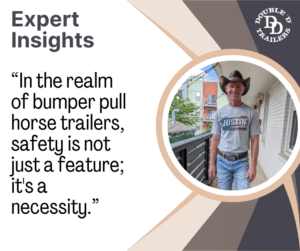
One happy Double D Trailers client, Christi of Atlanta, Georgia, couldn't agree more: "I wanted to know that my horse was as safe as possible on the road and I feel that DoubleD Trailers has created a very safe product that provides as much protection as I can get in a Bumper Pull." Read Christi's entire feedback here: Double D Trailers SafeTack 2 Horse Bumper Pull Review
What Does Brad Recommend for Optimal Trailer Safety?
Here’s how Brad, an expert with 25+ years of industry-specific experience, can wrap up the essentials of bumper pull horse trailer safety:
"In the realm of bumper pull horse trailers, safety is not just a feature; it's a necessity. As the owner of Double D Trailers, I've dedicated my career to ensuring that every trailer rolling out of our facility adheres to the highest safety standards. One of the key aspects of bumper pull trailer safety is the structural integrity of the trailer itself. We use only high-grade materials and advanced manufacturing techniques to ensure that each trailer is robust and capable of withstanding various road conditions. It’s not just about withstanding the rigors of travel but also about providing a safe and comfortable environment for the horses.
Another critical aspect is the inclusion of safety features such as proper ventilation, secure latching systems, and emergency exits. These features are designed to ensure the well-being of the horses during transit. Furthermore, it's essential for the towing vehicle to be compatible with the trailer in terms of size and towing capacity. This ensures that the trailer is stable and less prone to swaying or jack-knifing. At Double D Trailers, we also emphasize the importance of regular maintenance and inspections. Checking the brakes, tires, and lighting systems before each trip can significantly reduce the risk of accidents. Remember, safety in bumper pull horse trailers is a combination of quality construction, thoughtful design, and diligent maintenance. As responsible owners, it's crucial to prioritize these aspects to ensure a safe journey for both the horses and the driver."
Your Go-to Checklist for Bumper Pull Horse Trailer Safety
To guarantee the ultimate horse trailer safety, you should use a checklist to confirm you never miss an important aspect. Here’s how it should look:
- Consider the weight, size, number, and behavior of your horses
- Always calculate tongue weight and keep the trailer balanced when loaded
- Inspect the hitch and its attributes
- Ensure proper ventilation
- Check the electrical and braking systems before you use the trailer
- Maintain correct tire pressure
- Assess the trailer’s floors, running gear, and structural integrity
- Allow for safe loading and unloading
We've also written a comprehensive list of must-have safety features of a bumper pull horse trailer.
Choose the Right Bumper Pull Horse Trailer Type For Safety
Using this guide, you now know what safety features and systems a bumper pull horse trailer should be equipped with and how to enhance the safety and well-being of your horses during loading/unloading and while on the road.
If you already own a bumper pull horse trailer, keeping it clean and maintaining it regularly, as advised by the manufacturer, is essential, and the easy steps we’ve listed above will allow you to do it the right way without wasting time, effort, and resources. Performing regular checks always reduces the risk of malfunctions, emergencies, and accidents.
If you're still on the hunt for a bumper pull horse trailer, then it's crucial to be informed about the various types of bumper pull horse trailers available in the market. Each type comes with its own set of features and safety mechanisms, tailored to meet different needs and preferences. We understand that navigating through the plethora of options can be daunting, so we've prepared a review of the most popular bumper pull horse trailer types.
Read Now! Best and Worst Bumper Pull Horse Trailers
